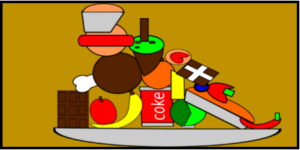6 Tasty Lawsuits Involving Food and Drink
 We are what we eat – and then we sue over it.
We are what we eat – and then we sue over it.
Food and drink fuel a steady stream of litigation, and almost without fail the cases are interesting, enlightening or downright absurd.
Everyone knows about the McDonald’s coffee case of 1992, where a jury awarded a 79-year-old woman $2.9 million (later reduced to around $500,000 in settlement) for injuries suffered from a spilled cup of scalding java.
What you may not know is that decades later people are still talking – and by “talking” I mean arguing, often vehemently – about the case. A video documentary in 2013 was viewed more than a million times and sparked thousands of online comments.
Whatever your opinion, the case was no laughing matter for the plaintiff, who sustained severe injuries and significant medical bills.
How Many Ice Cubes are Too Many?
On the other end of the spectrum is the aggrieved Starbucks customer in California who sued because his cold drink had too much ice.
In a proposed class action complaint, the plaintiff alleged his 24-oz Venti cup of iced tea contained only 14 ounces of fluid. The rest was ice. He sued for fraud, negligent misrepresentation, breach of warranty and unjust enrichment.
In dismissing the complaint as a tempest in a teacup, U.S. District Judge Percy Anderson suggested the proper remedy was for the plaintiff to grow up:
“[A]s young children learn, they can increase the amount of beverage they receive if they order no ice. If children have figured out that including ice in a cold beverage decreases the amount of liquid they will receive, the court has no difficulty concluding that a reasonable consumer would not be deceived into thinking that when they order an iced tea, that the drink they receive will include both ice and tea and that for a given size cup, some portion of the drink will be ice rather than whatever liquid beverage the consumer ordered.”
Six Other Fun Food Lawsuits
- Now that’s what I call finger food. In 2005, a woman said she found a human finger in a cup of Wendy’s chili. Turns out she put the finger there. Her husband bought it for $100 from a co-worker who had it chopped off in an accident. She dropped the suit but was convicted on felony fraud charges and served four years in prison. Wendy’s said it lost more than $2.5 million in revenue as a result of the publicity.
- Imaginary invasion of the mutant chickens. Kentucky Fried Chicken won more than $300,000 and injunctive relief against three Chinese companies for spreading false rumors on social media that The Colonel was using genetically-mutated birds with 8 legs and 6 wings.
- Enjoying a pound of flesh. A customer bit into an inch-long chunk of human thumb in an Arby’s chicken sandwich that fell into a food tub after a restaurant manager sliced it off shredding lettuce. The case was resolved out of court.
- Don’t call my chicken chewy! A Benhina restaurant in Kuwait sued a food blogger for an online review in which he said the chicken was “very chewy” and “tasted terrible” which doesn’t sound so bad. But the restaurant took offense and fired back with a lawsuit for “insulting, doubting the quality and food served by Benihana and using expressions that disgust people from trying the food.” Benihana won the equivalent of $3,600 USD.
- How much is that apron really worth? The California Culinary Academy in San Francisco agreed to a $40 million settlement in a class action lawsuit alleging the school inflated the value of its degrees and misrepresented graduates’ job prospects. Students paid between $17,000 and $35,000 for a diploma that one expert said was less valuable than a few months of interning under a master chef.
- Eat More … whatever. Chick-Fil-A moved to block a trademark application from a small t-shirt company in Vermont that wanted to use the slogan “Eat More Kale.” Chick-Fil-A said it owned the intellectual property rights to the phrase “Eat More” and that approving the application would dilute its brand and cause customer confusion.
So what are you having for lunch today?
Sources:
- New York Times http://www.nytimes.com/2013/10/28/booming/storm-still-brews-over-scalding-coffee.html?_r=0
- Yahoo! Finance http://finance.yahoo.com/news/too-much-ice-starbucks-lawsuits-000000464.html
- Yahoo! Finance http://finance.yahoo.com/news/kfc-just-proved-rumors-mutant-220131471.html
- LA Weekly http://www.laweekly.com/restaurants/top-10-food-related-lawsuits-of-2011-2382387
- Consumer Attorneys of California https://www.caoc.org/?pg=facts




